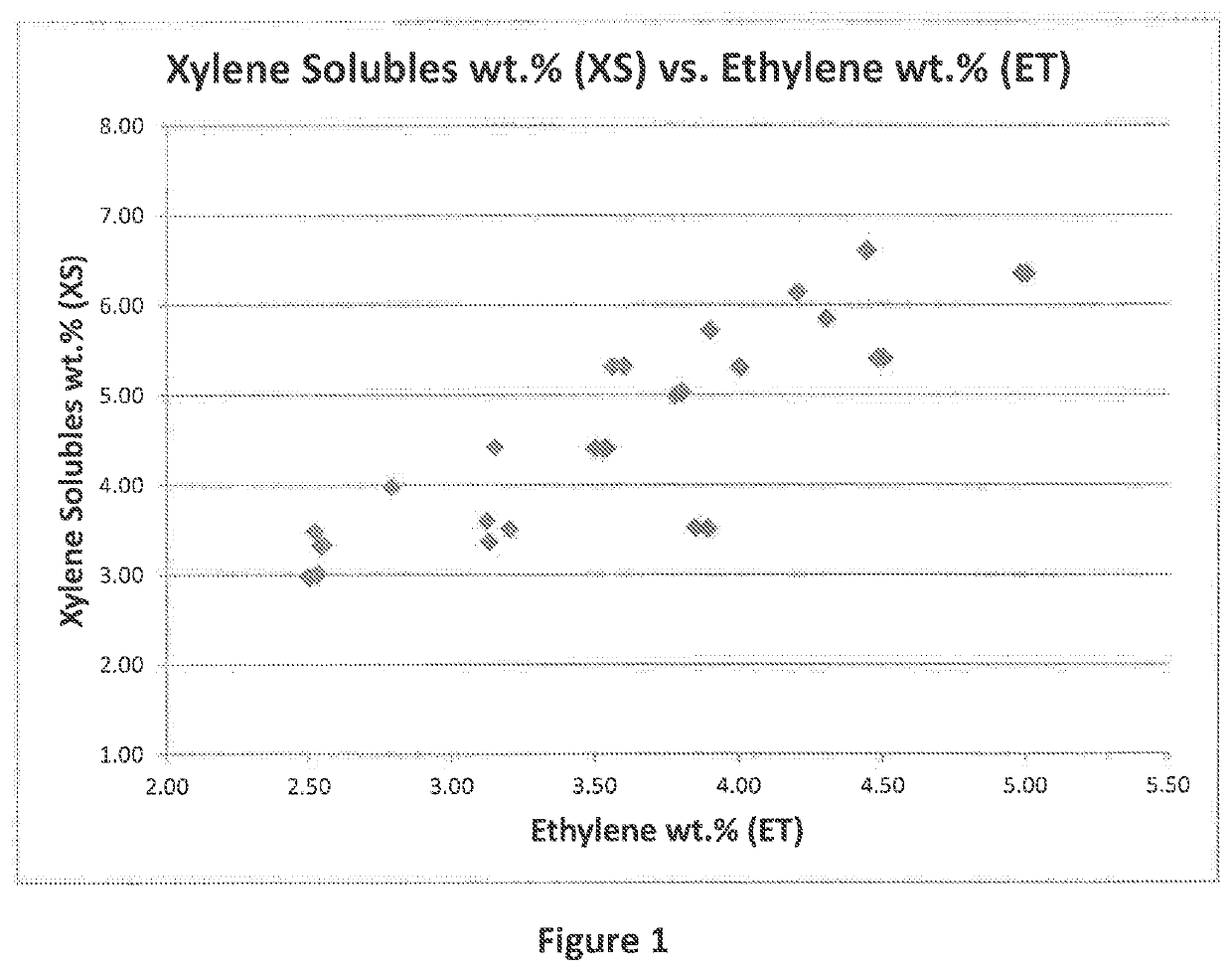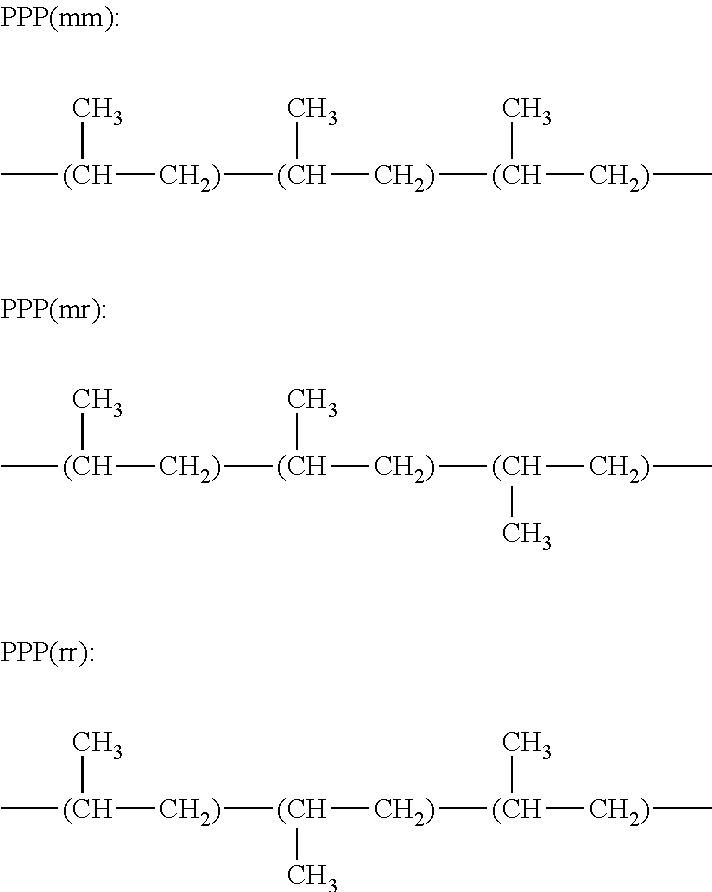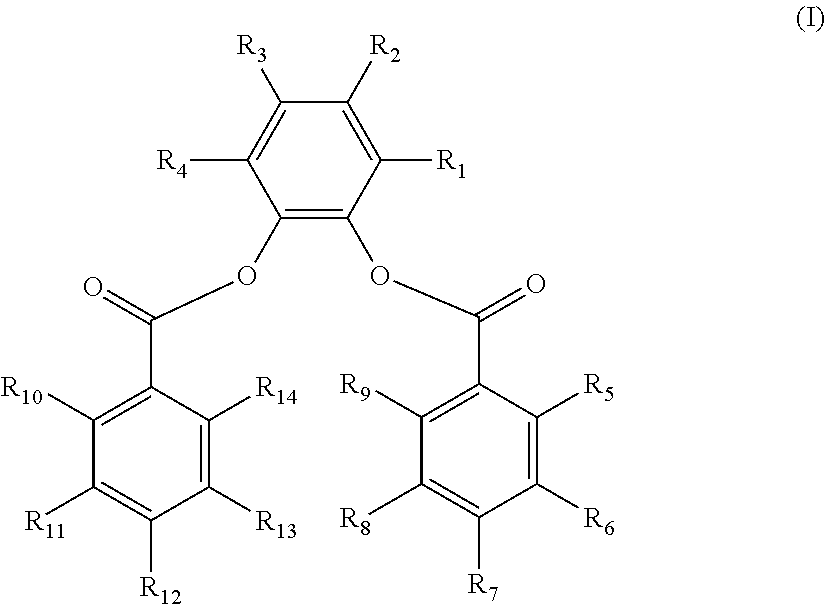Propylene-ethylene copolymer compositions suitable for hot fill packaging of foodstuffs
a technology of propylene-ethylene and composition, which is applied in the field of propylene-ethylene copolymer compositions, can solve the problems of undesirable breakdown of polymer or other components in the composition, temperature loss of packaging properties including stiffness and strength, and low extraction rate, and achieve excellent balance of properties. , the effect of high stiffness
- Summary
- Abstract
- Description
- Claims
- Application Information
AI Technical Summary
Benefits of technology
Problems solved by technology
Method used
Image
Examples
example no.1
Example No. 1
[0122]Propylene-ethylene random copolymer samples were produced and their properties tested in accordance with the procedures outlined above. The properties and experimental results are outlined in Table 1. Also, FIG. 1 includes a graph of xylene solubles to ethylene content.
[0123]The propylene-ethylene random copolymers were produced with a stereospecific 6th generation Ziegler-Natta magnesium supported / titanium-based catalyst. The catalyst contained a non-phthalate internal donor producing polymers having a broader molecular weight distribution than polymers made using metallocene catalyst. The process used to produce the polymers is described in the art as the UNIPOL gas phase process. The catalyst used to produce the polymers included a substituted phenylene aromatic diester internal electron donor. The catalyst used is commercially available from W.R. Grace and Company and sold under the trade name CONSISTA. All copolymers were made using triethylaluminum as a coca...
example no.2
Example No. 2
[0124]Another propylene-ethylene random copolymer was made in accordance with the present disclosure using generally the same process as described above and compared to a control having all XS / ET ratio of 2. The propylene-ethylene random copolymers were injection molded into test plaques and tested for haze. Haze was tested initially and after thermal aging. The propylene-ethylene random copolymers are as follows:
TABLE 2Propylene-Ethylene Random Copolymer ExamplesEthyleneXSMFRSamplewt. %(wt. %) wetXS / ET(g / 10 min)Comparative4.108.22.0040.7353.785.01.3342.4
[0125]Haze was measured according to ASTM Test D1003, procedure A using the latest version of the test. Haze was measured before and after 24 hour thermal aging at 55° C. using BYK Gardner Haze-Gard Plus 4725 instrument. Thermal aging was conducted by placing the plaque samples into an oven. During thermal aging, propylene polymer compositions have a tendency to increase in haze. Haze is increased due to further crystal...
example no.3
Example No. 3
[0130]Propylene-ethylene random copolymer samples were produced using the same procedures as described in Example No. 1. The samples were tested for various physical properties. The following results were obtained:
Sample No.363738XS(wt %) wet3.57.99.4MF (g / 10 min)11.812.111.4Et (wt %)3.94.14.2Gardner Impact10.026.471.3Strength (at 23° C.inch-lbs)Flex. Mod., (MPa)164800131800128000N-Izod, (ft-lb / in), RT1.393.154.87Haze, %9.18.29.0
[0131]As shown above, Sample No. 36 had improved stiffness in relation to Sample Nos. 37 and 38.
PUM
| Property | Measurement | Unit |
|---|---|---|
| melt flow rate | aaaaa | aaaaa |
| melt flow rate | aaaaa | aaaaa |
| haze | aaaaa | aaaaa |
Abstract
Description
Claims
Application Information
 Login to View More
Login to View More - R&D
- Intellectual Property
- Life Sciences
- Materials
- Tech Scout
- Unparalleled Data Quality
- Higher Quality Content
- 60% Fewer Hallucinations
Browse by: Latest US Patents, China's latest patents, Technical Efficacy Thesaurus, Application Domain, Technology Topic, Popular Technical Reports.
© 2025 PatSnap. All rights reserved.Legal|Privacy policy|Modern Slavery Act Transparency Statement|Sitemap|About US| Contact US: help@patsnap.com



